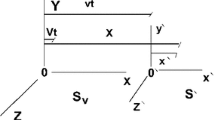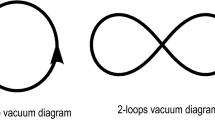Abstract
The condensed matter examples, in which the effective gravity appears in thelow-energy corner as one of the collective modes of quantum vacuum, providea possible answer to the question, why the vacuum energy is so small. Thisanswer comes from the fundamental “trans-Planckian” physics of quantum liquids. In the effective theory of the low energy degrees of freedom the vacuum energy density is proportional to the fourth power of the corresponding“Planck” energy appropriate for this effective theory. However, from the exact “Theory of Everything” of the quantum liquid it follows that its vacuum energy density is exactly zero without fine tuning, if: there are no external forces acting on the liquid; there are no quasiparticles which serve as matter; no space-time curvature; and no boundaries which give rise to the Casimireffect. Each of these four factors perturbs the vacuum state and induces anonzero value of the vacuum energy density, which is on the order of theenergy density of the perturbation. This is the reason, why one must expectthat in each epoch the vacuum energy density is on the order of the matterdensity of the Universe, or/and of its curvature, or/and of the energy density of the smooth component–the quintessence.
Similar content being viewed by others
REFERENCES
R.B. Laughlin and D. Pines, The Theory of Everything, Proc. Natl. Acad. Sc. USA 97, 28-31 (2000).
C.D. Frogatt and H.B. Nielsen, Origin of Symmetry, World Scientific, Singapore-New Jersey-London-Hong Kong, 1991.
S. Chadha, and H.B. Nielsen, Lorentz invariance as a low-energy phenomenon, Nucl. Phys. B 217, 125-144 (1983).
G.E. Volovik, Superfluid analogies of cosmological phenomena, to appear in Phys. Rept. [gr-qc/0005091].
W.G. Unruh, Experimental black-hole evaporation?, Phys. Rev. Lett. 46, 1351-1354 (1981); W.G. Unruh, Sonic analogue of black holes and the effects of high frequencies on black hole evaporation, Phys. Rev. D 51, 2827–2838 (1995); M. Visser, Acoustic black holes: horizons, ergospheres, and Hawking radiation, Class. Quant. Grav. 15, 1767–1791 (1998).
M. Stone, Phonons and forces: momentum versus pseudomomentum in moving fluids, cond-mat/0012316.
S. Weinberg, The cosmological constant problem, Rev. Mod. Phys. 61, 1-23 (1989); S. Weinberg, The cosmological constant problems, astro-ph/0005265.
D. Polarski, Accelerated expansion: Theory and observations, J. Low Temp. Phys., this issue.
Supernova Cosmology Project (S. Perlmutter et al.), Measurements of Ω and Λ from 42 high redshift supernovae, Astrophys. J. 517, 565-586 (1999).
C.W. Woo, Microscopic calculations for condensed phases of helium, in The Physics of Liquid and Solid Helium, Part I, eds. K.H. Bennemann and J.B. Ketterson, John Wiley & Sons, New York, 1976.
F. Ravndal, Problems with the Casimir vacuum energy, hep-ph/0009208.
J. D. Bjorken, Standard model parameters and the cosmological constant, hep-ph/0103349.
R.R. Caldwell, R. Dave, and P.J. Steinhardt, Cosmological imprint of an energy component with general equation of state, Phys. Rev. Lett. 80, 1582-1585 (1998).
M.S. Turner and M. White, CDM models with a smooth component, Phys. Rev. D 56, R4439-R4443 (1997).
D. Vollhardt, and P. Wölfle, The superfluid phases of helium 3, Taylor and Francis, London-New York-Philadelphia, 1990.
G. Chapline, E. Hohlfeld, R.B. Laughlin, and D.I. Santiago, Quantum phase transitions and the breakdown of classical general relativity, gr-qc/0012094.
A. Einstein, Kosmologische Betrachtungen zur allgemeinen Relativitätstheorie, Sitzungsber. Konigl. Preuss. Akad. Wiss. 1, 142-152 (1917).
Author information
Authors and Affiliations
Rights and permissions
About this article
Cite this article
Volovik, G.E. Vacuum Energy and Cosmological Constant: View from Condensed Matter. Journal of Low Temperature Physics 124, 25–39 (2001). https://doi.org/10.1023/A:1017561415063
Issue Date:
DOI: https://doi.org/10.1023/A:1017561415063




